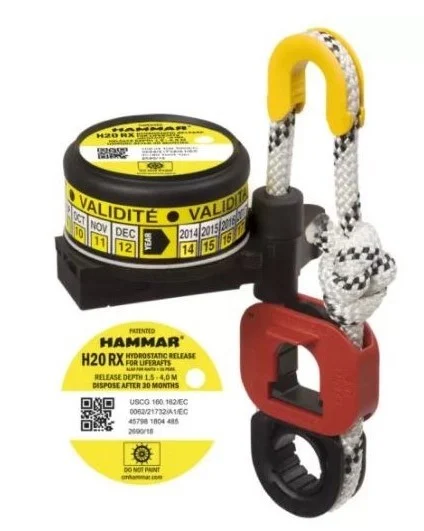When you look at a life raft on deck, you mostly think of the canister, the cradle, and the lashings. But there’s a small piece of equipment in that whole arrangement that can literally make the difference between life and death, the HRU or Hydrostatic Release Unit.
What Exactly is an HRU?
In simple terms, the HRU is a device fitted to the life raft (or EPIRB, if separate) that automatically releases it from the ship if the vessel sinks. It works on water pressure — when submerged to a certain depth, the HRU activates and cuts the securing strap, allowing the raft to float free and inflate.
No electricity. No buttons. No human help. Just automatic release by water pressure.
Usually, the activation depth is around 1.5 to 4 metres.
Why Is It So Important?
Imagine a situation the vessel is sinking, nobody had time to manually launch the raft. If the raft is just lashed tightly, it will go down with the ship. But with an HRU, the raft will automatically release, float up, and inflate itself, increasing survival chances for anyone who can reach it.
So, even if everyone is unable to reach the raft, it might still be usable later by rescue teams or floating survivors.
How It Works (Simple Way to Explain):
- Raft is placed in a cradle.
- It is secured with a lashing that passes through the HRU.
- The HRU is attached to a weak link and a senhouse slip.
- If the ship sinks, pressure increases as water depth increases.
- At a certain depth (around 1.5-4 metres), the HRU blade cuts the rope/lashing.
- Raft floats up and inflates when the painter line is pulled fully.
Types of HRU:
•For Life Rafts
•For EPIRBs
(Some HRUs are dual purpose, but most are specific to equipment.)
What Must Cadets and Junior Officers Know?
Check the expiry date of the HRU regularly. Usually valid for 1 or 2 years.
Understand the difference between manual release and HRU activation.
During inspection, ensure the weak link is intact and correctly rigged.
HRU should be approved type – check for SOLAS marking or manufacturer stamp.
Know how to re-assemble the life raft cradle and HRU during drills or training.
HRU should never be painted or tampered with, it’s a precise device.
Some Questions That Can Be Asked in Orals or Exams:
- What is the function of an HRU?
- At what depth does the HRU activate?
- What is a senhouse slip?
- How does the HRU contribute to SOLAS requirements?
- What is the difference between a weak link and senhouse slip?
- How often should an HRU be replaced?
- Can HRUs be reused after one activation?
- What checks are done during monthly inspections?
Inspection Tips from the Bridge:
During monthly LSA checks, note HRU expiry in logbook.
Make sure the painter line is correctly tied to the strong point and not the raft container.
Ensure HRU is not corroded or loosely mounted.
In PSC or vetting inspections, expired HRUs are a common deficiency — easy to avoid with regular attention.
In the End…
It’s small, it’s quiet, and it just sits there. But when things go wrong, the HRU does its job without needing anyone’s help. That’s the kind of backup every seafarer should respect.
So next time you walk past the life raft, don’t just look at the canister — look at the HRU too. It might save your life one day.
Stay safe and alert


